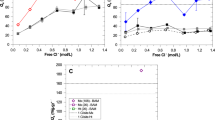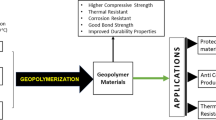Abstract
Converter steel slag, currently underutilized crystalline metallurgical residue, was investigated for use as a precursor for alkali activation. Water glass solution with various moduli (0.5, 1.0, 1.5 and 2.0) was used at the same Na2O dosage of 4% in order to investigate effect of modulus on hydration. Pure cement paste with the same ratio of water to binder was selected as the control sample. Results show that modulus has a significant impact on the hydration and mechanical strength development of alkali-activated steel slag. Similar to pure cement paste, alkali-activated steel slag paste has C–S–H gel and Ca(OH)2 as its main hydration products. However, alkali-activated steel slag pastes have lower hydration heat and fewer amounts of hydration products. Additional silicate has a retarding effect on the hydration of steel slag. Hydration heat, Ca(OH)2 contents and non-evaporable water contents reduce with increasing modulus. In addition, high silicate modulus fines the pore structure and improves compressive strength of the hardened paste.











Similar content being viewed by others
References
Sun J, Wang Z, Chen Z. Hydration mechanism of composite binders containing blast furnace ferronickel slag at different curing temperatures. J Therm Anal Calorim. 2018;131(3):2291–301.
Sun J, Chen Z. Influences of limestone powder on the resistance of concretes to the chloride ion penetration and sulfate attack. Powder Technol. 2018;338:725–33.
Wang D, Wang Q, Fang Z. Influence of alkali activators on the early hydration of cement–based binders under steam curing condition. J Therm Anal Calorim. 2017;130(1):1–16.
Tang SW, Yao Y, Li CAZJ. Recent durability studies on concrete structure. Cem Concr Res. 2015;78:143–54.
Ding Y, Dai JG, Shi CJ. Mechanical properties of alkali-activated concrete: a state-of-the-art review. Constr Build Mater. 2016;127:68–79.
Kani EN, Allahverdi A, Provis JL. Calorimetric study of geopolymer binders based on natural pozzolan. J Therm Anal Calorim. 2017;127(3):1–10.
Pacheco-Torgal F, Castro-Gomes J, Jalali S. Alkali-activated binders: a review: part 1. Historical background, terminology, reaction mechanisms and hydration products. Constr Build Mater. 2008;22(7):1305–14.
Pacheco-Torgal F, Castro-Gomes J, Jalali S. Alkali-activated binders: a review. Part 2. About materials and binders manufacture. Constr Build Mater. 2008;22(7):1315–22.
Wang Q, Yan P, Feng J. A discussion on improving hydration activity of steel slag by altering its mineral compositions. J Hazard Mater. 2011;186(2–3):1070–5.
Shi M, Wang Q, Zhou Z. Comparison of the properties between high-volume fly ash concrete and high-volume steel slag concrete under temperature matching curing condition. Constr Build Mater. 2015;98:649–55.
Wang Q, Shi M, Yang J. Influence of classified steel slag with particle sizes smaller than 20 μm on the properties of cement and concrete. Constr Build Mater. 2016;123:601–10.
Han F, Zhang Z. Properties of 5-year-old concrete containing steel slag powder. Powder Technol. 2018;334:27–35.
Kriskova L, Pontikes Y, Cizer Mertens G, Veulemans W, Geysen D, Jones PT, Vandewalle L, Van Balen K, Blanpain B. Effect of mechanical activation on the hydraulic properties of stainless steel slags. Cem Concr Res. 2012;42(6):778–88.
Kriskova L, Pontikes Y, Zhang F, Cizer Jones PT, Van Balen K, Blanpain B. Influence of mechanical and chemical activation on the hydraulic properties of gamma dicalcium silicate. Cem Concr Res. 2014;55(1):59–68.
Kriskova L, Pontikes Y, Cizer Malfliet A, Dijkmans J, Sels B, Van Balen K, Blanpain B. Hydraulic behavior of mechanically and chemically activated synthetic merwinite. J Am Ceram Soc. 2014;97(12):3973–81.
Shi C. Characteristics and cementitious properties of ladle slag fines from steel production. Cem Concr Res. 2002;32:459–62.
Shi C, Hu S. Cementitious properties of ladle slag fines under autoclave curing conditions. Cem Concr Res. 2003;33(11):1851–6.
Yusuf MO, Johari MAM, Ahmad ZA. Impacts of silica modulus on the early strength of alkaline activated ground slag/ultrafine palm oil fuel ash based concrete. Mater Struct. 2015;48(3):733–41.
Gao X, Yu QL, Brouwers HJH. Reaction kinetics, gel character and strength of ambient temperature cured alkali activated slag–fly ash blends. Constr Build Mater. 2015;80:105–15.
Chi M. Effects of modulus ratio and dosage of alkali-activated solution on the properties and micro–structural characteristics of alkali-activated fly ash mortars. Constr Build Mater. 2015;99:128–36.
Shi Z, Shi C, Wan S. Effects of alkali dosage and silicate modulus on alkali–silica reaction in alkali-activated slag mortars. Cem Concr Res. 2018;111:104–15.
Krizan D, Zivanovic B. Effects of dosage and modulus of water glass on early hydration of alkali–slag cements. Cem Concr Res. 2002;32(8):1181–8.
Zhao J, Wang D, Yan P. Self-cementitious property of steel slag powder blended with gypsum. Constr Build Mater. 2016;113:835–42.
Gebregziabiher BS, Thomas RJ, Peethamparan S. Temperature and activator effect on early-age reaction kinetics of alkali-activated slag binders. Constr Build Mater. 2016;113:783–93.
Rashad AM, Bai Y, Basheer PAM. Chemical and mechanical stability of sodium sulfate activated slag after exposure to elevated temperature. Cem Concr Res. 2012;42(2):333–43.
Salman M, Cizer Ö, Pontikes Y. Alkali activation of AOD stainless steel slag under steam curing conditions. J Am Chem Soc. 2015;98(10):3062–74.
Salman M, Pontikes Y, Snellings R. Cementitious binders from activated stainless steel refining slag and the effect of alkali solutions. J Hazard Mater. 2015;286:211–9.
Wieczorek-ciurowa K, Paulik J, Paulik F. Influence of foreign materials upon the thermal decomposition of dolomite, calcite and magnesite part I. Influence of sodium chloride. Thermochim Acta. 1980;38:157–64.
Taylor H. Cement chemistry. 1st ed. London: Academic Press Limited; 1990.
Pang B, Zhou Z, Xu H. Utilization of carbonated and granulated steel slag aggregate in concrete. Constr Build Mater. 2015;84:454–67.
Nazari A, Riahi S. Microstructural, thermal, physical and mechanical behavior of the self-compacting concrete containing SiO2 nanoparticles. Mater Sci Eng A. 2010;527(29):7663–72.
Nicolas RS, Bernal SA, Gutiérrez RMD. Distinctive microstructural features of aged sodium silicate-activated slag concretes. Cem Concr Res. 2014;65(11):41–51.
Leong HY, Ong DEL, Sanjayan JG. The effect of different Na2O and K2O ratios of alkali activator on compressive strength of fly ash based-geopolymer. Constr Build Mater. 2016;106:500–11.
Ryu GS, Lee YB, Koh KT. The mechanical properties of fly ash-based geopolymer concrete with alkaline activators. Constr Build Mater. 2013;47(5):409–18.
Acknowledgements
Authors acknowledge the support from the National Key Research and Development Program of China (2017YFC1503100).
Author information
Authors and Affiliations
Corresponding author
Ethics declarations
Conflict of interest
The authors declare that they have no conflict of interest.
Additional information
Publisher's Note
Springer Nature remains neutral with regard to jurisdictional claims in published maps and institutional affiliations.
Rights and permissions
About this article
Cite this article
Sun, J., Chen, Z. Effect of silicate modulus of water glass on the hydration of alkali-activated converter steel slag. J Therm Anal Calorim 138, 47–56 (2019). https://doi.org/10.1007/s10973-019-08146-3
Received:
Accepted:
Published:
Issue Date:
DOI: https://doi.org/10.1007/s10973-019-08146-3




